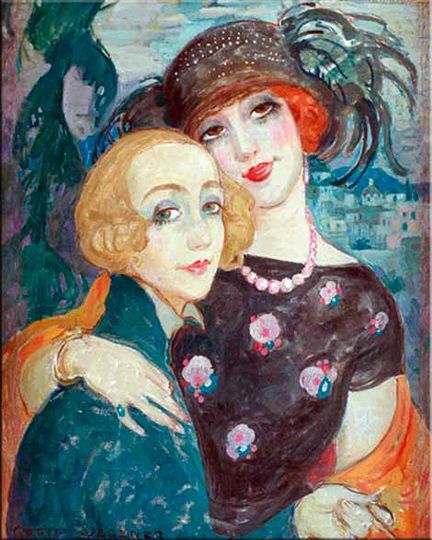The artist Gerda Wegener (née Gottlieb) was born in semi-rural Denmark into a conservative and religious family. As a young woman with a promising artistic talent, she was later allowed to attend the Royal Danish Academy of Fine Arts in Copenhagen. It was here, in 1904, that Gerda first met fellow artist and landscape painter who’s given name was Einar Magnus Andreas Wegener, but who would later become globally known as Lili Elbe.
It is believed they married at the ages of 19 and 22 years old.

Gerda Wegener
After Gerda graduated in 1907 the couple travelled around Europe, eventually settling in Paris. The artist hoped that the French capital would offer her an artistic opportunity in the world of fashion. Gerda’s work was shown at various exhibitions and she eventually gained a living in advertising creating posters. Here she developed a specific art deco figurative style. Her work, often featuring women and erotica, was considered too risqué in her homeland, but was readily accepted in the more relaxed atmosphere of Bohemian Paris.

Gerda Wegener, A Summer Day-detail, 1927
Gerda and her partner soon became well acquainted with the dancers, intellectuals, fellow artists and the radical lifestyle of the capital. It was at this time that Elbe began to present as Lili. The artist, like Gerda, had also worked as an illustrator to earn money and had been a successful landscape painter, even exhibiting at the Salon in Paris, but had ceased painting believing it was part of a former life.

Poples along Hobro Fjord, 1908 signed in Elbe’s former name.
Gerda, however, continued in her work, sometimes utilising Lili as model. Little did her viewers know the story behind her new muse. The circumstances of their complex bond both on a personal and artistic level was somewhat unconventional, even for the relaxed atmosphere of Paris in the early 20th century.
Lili Elbe, 1926
By this time Gerda had become involved in a new relationship which evolved into an unhappy marriage and a period of time spent in North Africa. Later divorced, she spent the last years of her life alone.
The story of Gerda and Lili, which inspired the film ‘The Danish Girl’, has been perceived by many as challenging the typical gendered power dynamics of artist master and model. Gerda’s work has also been praised for her bold depictions of independent women, including lesbian erotica, created from the female rather than typically male gaze.

The entwined bond of artist Gerda and former artist Lili, is certainly one of historical interest, and has a significant place in the history of both culture and art.
